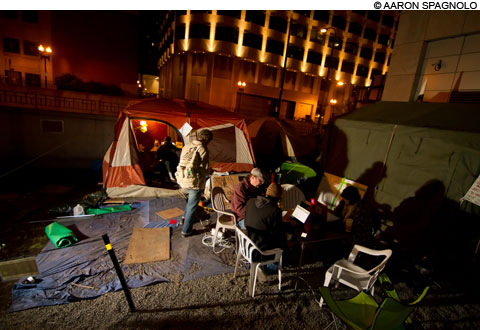
PITCHING IN Like much of the Occupy Boston effort, the media-relations team had to hit the ground running, often working with inadequate resources on whatever challenges arose — from tech demands to interview requests. |
It's a familiar scene outside the Occupy Boston media tent: a local television news reporter and her cameraman approach cautiously, looking for a clue. They inch up to the closed zipper door, and the talent cups her ear to check if anyone's inside. She hears voices, and softly says, "Um . . . hello? Anybody who can help with media requests in there?"The zipper opens halfway, and a twentysomething with an Einstein 'fro pokes his melon out like the Wonderful Wizard. He removes his shades, inspects the newswoman in her skirt suit, and says nothing. The reporter asks, "Is there someone who does interviews?" To which the occupier responds, before disappearing back into his weatherproof bunker, "Anyone can talk to you — but they only speak for themselves."
Unlike welcome desks at political conventions, at Occupy Boston there are no credentials, gift bags, or lanyards stitched with corporate logos. The sign out front this tent might say MEDIA, but in reality it hosts a hodgepodge battalion of social-networking flacks, programmers and spin surgeons, in-house hacks and bloggers — a squad that isn't in business to service the mainstream media.
Participants like Nadeem Mazen — an MIT grad and owner of a Cambridge tech consulting firm who's been a de facto mouthpiece for the movement from early on — have indeed granted hundreds of outside interviews. But in those exchanges and through their own outlets, vols primarily focus on disseminating news from the general Occupy perspective, and on correcting what they consider to be misinformation.
Though still in dire need of outside contributions, Occupy Boston media has come a long way since last month, when their whole output consisted of a Twitter feed and a Facebook page. Still, the ensemble force is not yet the dynamic machine needed for this sort of massive operation — especially if there's no coherent, unified message to push. Also discouraging is that Occupy Boston media has suffered from an identity crisis, as the team was initially formed to handle an impossible range of tasks, from technological needs to public relations.
At this time, the group lacks adequate tools, manpower, and capability, as the majority of occupiers don't have laptops or smart phones. According to Mazen, the team is still far from being able to process revolution in real time. Robin Jacks, a 31-year-old Occupy activist who earned her stripes backing lefty causes in her native Memphis, agrees that there are limitations, but says it's important to note the velocity at which they hit the ground running."Every day people ask us, 'What's your message?' " says Jacks. "We're working on that, but it takes time. Other movements had months or even years to figure these things out. We're just getting started."
UNDER SIEGEThe media team's first big test came in the late hours of Columbus Day, when police descended on the Rose Kennedy Greenway to arrest Occupy squatters who'd staged a secondary camp. Under siege, the team furiously gathered footage and information, and by any measure handled the crisis competently, shaping the emerging narrative according to their experience.